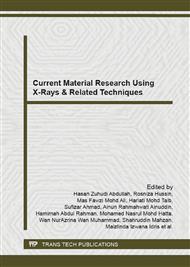p.321
p.329
p.334
p.340
p.345
p.350
p.355
p.360
p.365
Preliminary Studies of the Effects of Polyethylene Glycol/Hydroxyapatite Powder-Binder System for 3D Printing Application
Abstract:
The role of binder in powder system has gained its importance lately in 3D printing (3DP) applications. This research aims to investigate the effect of powder system developed from incorporation of polyethylene glycol (PEG) onto hydroxyapatite (HAP) powder for 3D printing application. Simple spray method was used to incorporate mixture of PEG into HAP powder. Raw commercial HAP powder was determined by using particle size analyser. The morphology and crystallinity of raw HAP powder and powder mixture were characterised by using Scanning Electron Microscopy (SEM) and X-ray Diffractive (XRD) analysis. Mean particle size of raw HAP was found to be 4.77 μm which is suitable for 3D printing and in good agreement with SEM micrographs. Based on the SEM micrographs, the powder mixture was found in agglomerated and small particle form. Small amount of PEG (2 wt. % to 7 wt. %) incorporation onto HAP powder exhibited absence of new phases on XRD analysis, demonstrating good chemical compatibility. Based on this study, it can be concluded that incorporating PEG onto HAP powder is able to maintain the initial characteristic of HAP and can work together as powder system.
Info:
Periodical:
Pages:
345-349
Citation:
Online since:
February 2015
Authors:
Keywords:
Price:
Сopyright:
© 2015 Trans Tech Publications Ltd. All Rights Reserved
Share:
Citation:


